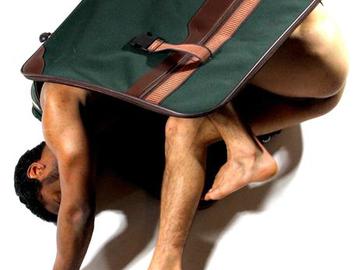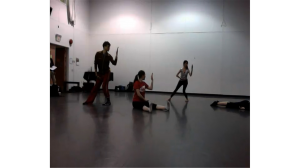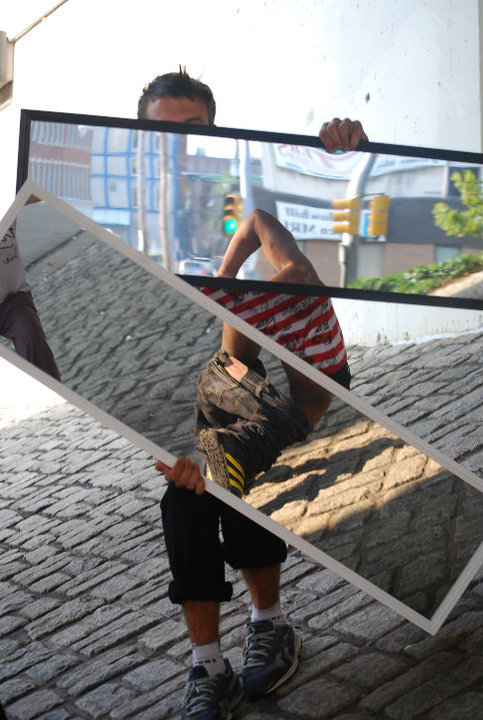Hello folks,
This past summer, journalist Bruce Walsh wrote a short series of articles centered around our work this summer on Private Places, then called The Flight Attendants Project. Below is the second article from Bruce, in which he explores some of the origins of J-Sette’s emergence into popular culture. J-Sette movement has been used as research for the Private Places project.
*also, check out our One-Year Vlog Project
J-Setting Marches Northward
– Bruce Walsh
The tiny staff of idiosynCrazy productions has done their best to cool the only slightly air-conditioned Live Arts Festival rehearsal space on Fifth and Poplar streets. They’ve closed the loading dock of this converted industrial building, desperately saving as much cool air as they can in the vast expanse, where fifteen Philadelphia dancers attempt to keep pace with Dante Beacham.
The barefoot twenty-four-year-old is the only person onstage without formal dance training. Yet today he is, without a doubt, at the head of the class.
Beacham leads them through a series of bold, sharp—almost cheerleader-esque—rapid-fire movements, all to a driving eight-count beat. After a water-break only a third of the dancers return to the stage. The rest watch, out of breath, as the remaining few complete the two-minute routine. When they do applause echoes off the rafters and dancers collapse on the floor in victory, as if they’ve just broken the ribbon at a distance race.
These Philly dancers have just had their first intensive exposure to J-Setting, from one of the current leaders on the J-Sette scene. Local choreographer Jumatatu Poe brought Beacham to Philadelphia to incorporate this club favorite into his latest work, The Flight Attendants Project, which is being developed with the assistance of a $50,000 grant from Dance Advance, an arm of the Pew Center for Arts and Heritage.
Most Americans have only been exposed to J-Setting through the 2008 Beyoncé video, “Single Ladies (Put a Ring On It),” in which choreographers Frank Gatson and JaQuel Knight appropriated the hallmarks of the style. Even Poe admits that the video sparked his fascination with the scene. In a 2009 interview with Vibe Magazine, Knight explained that he, Beyoncé, and Gatson researched J-Setting via YouTube. If so, they were likely influenced by Beacham. His videos are some of the most popular J-Setting clips out there. In an interview with the London Sunday Times, Beyoncé put it this way: “[We] added the down-South thing—it’s called J-Setting, where one person does something and the next person follows.”
That “down-South thing” is more accurately described as a distinctive feature of Southern, African-American gay culture. And many in that community were irked to see it borrowed without a please, thank you, or even an acknowledgment of where it came from.
“I feel as though [Knight] took credit for something that he has no idea about,” says Beacham, now sitting in the cooler confines of the Live Arts Festival’s office. “I feel like he went online, researched it, and took it as [if] he really knew what it was. I would love for someone from this community to be able to bring it to the world, and be able to explain what it is and what it means to us. Instead we have [Knight] trying to explain where it comes from. It bothers me.”
In fairness, explaining where J-Setting comes from is no easy task, and even the scene leaders are somewhat fuzzy on the details.
For starters, the form didn’t begin in the clubs, but on a Mississippi football field.
In 1971, the majorette section of the Jackson State University Marching Band abandoned baton twirling in favor of dancing to pop songs by James Brown and others. A huge hit with the crowd, the majorettes started calling themselves the Prancing Jaycettes. (In 1982, they changed the spelling to J-Settes.)
Their trademark eight-count, lead-and-follow groove was imitated—and later interpreted and evolved—by men in the surrounding area. Eventually, this style— called “bucking” in and around Jackson—started to appear in clubs across the South.
By 2000 the dance was synonymous with Southern gay culture. Dozens of formal male J-Sette teams competed at Atlanta and Memphis Pride festivals—and still do. Beacham’s team, Mystic Force, is one of the top squads going.
For many gay men in the South, J-Setting is a defiant, proud expression of sexuality, amidst some of the most repressive areas of the country. At any given Jackson State football game, groups of men lead their own J-Sette dances in the stands. “I’ve never done it [at the games]. I’m afraid to do it, to be honest with you,” says Beacham, who currently attends Jackson State. “I try to avoid violence, and I know some people are not as accepting as others.”
“We will see that, yes, every now an then we will see somebody imitating us in the stands,” says Kathryn Pinkston-Worthy, the current Prancing J-Sette coach and former 70s-era captain.
For the leader of the Prancing J-Settes, there is only a tacit acknowledgement of their interpretation in gay culture, and an extremely vague understanding of the larger phenomenon.
“From what I’m told—and I have never been there to witness any of it—but I’m told they have different groups in clubs, and they have uniforms, and they imitate the J-Settes,” says Pinkston-Worthy with the emphasis on imitate. “That must be where this ‘J-Setting’ comes from, because we definitely don’t call it that.”
Imagine her surprise when she turned on the television to find Beyoncé utilizing the club-infused interpretation of a J-Sette strut: “I was like, ‘Oh wait a minute, haven’t I seen this before?’”







